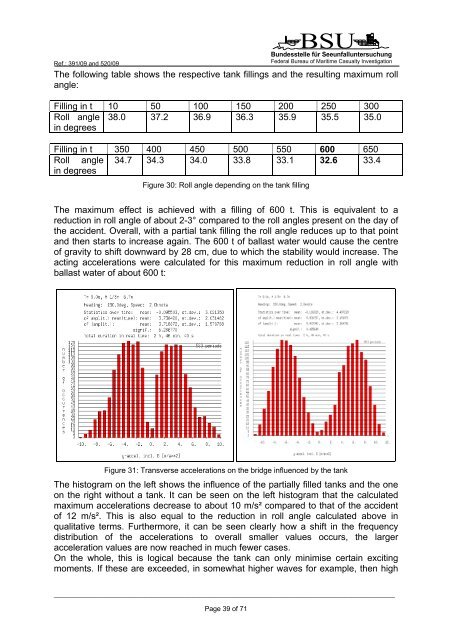SUB-COMMITTEE ON STABILITY AND LOAD LINES AND ON ...
SUB-COMMITTEE ON STABILITY AND LOAD LINES AND ON ...
SUB-COMMITTEE ON STABILITY AND LOAD LINES AND ON ...
Create successful ePaper yourself
Turn your PDF publications into a flip-book with our unique Google optimized e-Paper software.
Ref.: 391/09 and 520/09<br />
BSU<br />
Bundesstelle für Seeunfalluntersuchung<br />
Federal Bureau of Maritime Casualty Investigation<br />
The following table shows the respective tank fillings and the resulting maximum roll<br />
angle:<br />
Filling in t 10 50 100 150 200 250 300<br />
Roll angle 38.0 37.2 36.9 36.3 35.9 35.5 35.0<br />
in degrees<br />
Filling in t 350 400 450 500 550 600 650<br />
Roll angle 34.7 34.3 34.0 33.8 33.1 32.6 33.4<br />
in degrees<br />
Figure 30: Roll angle depending on the tank filling<br />
The maximum effect is achieved with a filling of 600 t. This is equivalent to a<br />
reduction in roll angle of about 2-3° compared to the roll angles present on the day of<br />
the accident. Overall, with a partial tank filling the roll angle reduces up to that point<br />
and then starts to increase again. The 600 t of ballast water would cause the centre<br />
of gravity to shift downward by 28 cm, due to which the stability would increase. The<br />
acting accelerations were calculated for this maximum reduction in roll angle with<br />
ballast water of about 600 t:<br />
Figure 31: Transverse accelerations on the bridge influenced by the tank<br />
The histogram on the left shows the influence of the partially filled tanks and the one<br />
on the right without a tank. It can be seen on the left histogram that the calculated<br />
maximum accelerations decrease to about 10 m/s² compared to that of the accident<br />
of 12 m/s². This is also equal to the reduction in roll angle calculated above in<br />
qualitative terms. Furthermore, it can be seen clearly how a shift in the frequency<br />
distribution of the accelerations to overall smaller values occurs, the larger<br />
acceleration values are now reached in much fewer cases.<br />
On the whole, this is logical because the tank can only minimise certain exciting<br />
moments. If these are exceeded, in somewhat higher waves for example, then high<br />
_____________________________________________________________________________________________________<br />
Page 39 of 71
















